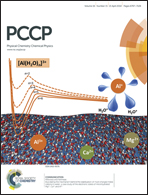Active hydrogen species on TiO2 for photocatalytic H2 production†
Abstract
Photocatalytic H2 production over TiO2 has attracted tremendous attention and achieved great progress, but the active hydrogen species is still unknown. Employing a rutile TiO2(110) surface as a model catalyst we report here for the first time the direct observation of photocatalytic H2 production under ultrahigh vacuum conditions during UV-light irradiation at 115 K and the identification of negatively-charged hydride-type H-Ti species as the corresponding photoactive surface species by means of thermal desorption spectroscopy, photon-stimulated desorption spectroscopy, X-ray photoelectron spectroscopy and DFT calculations. The formation and stability of H-Ti species are closely related to available surplus electrons on the rutile TiO2(110) surface that can be created by the formation of surface BBO vacancies or by the formation of surface hydroxyls via the adsorption of atomic H or molecular H2 on O sites. The photocatalytic H2 production from H-Ti species is hole-mediated and co-existing water exerts a negative effect on this process.


 Please wait while we load your content...
Please wait while we load your content...